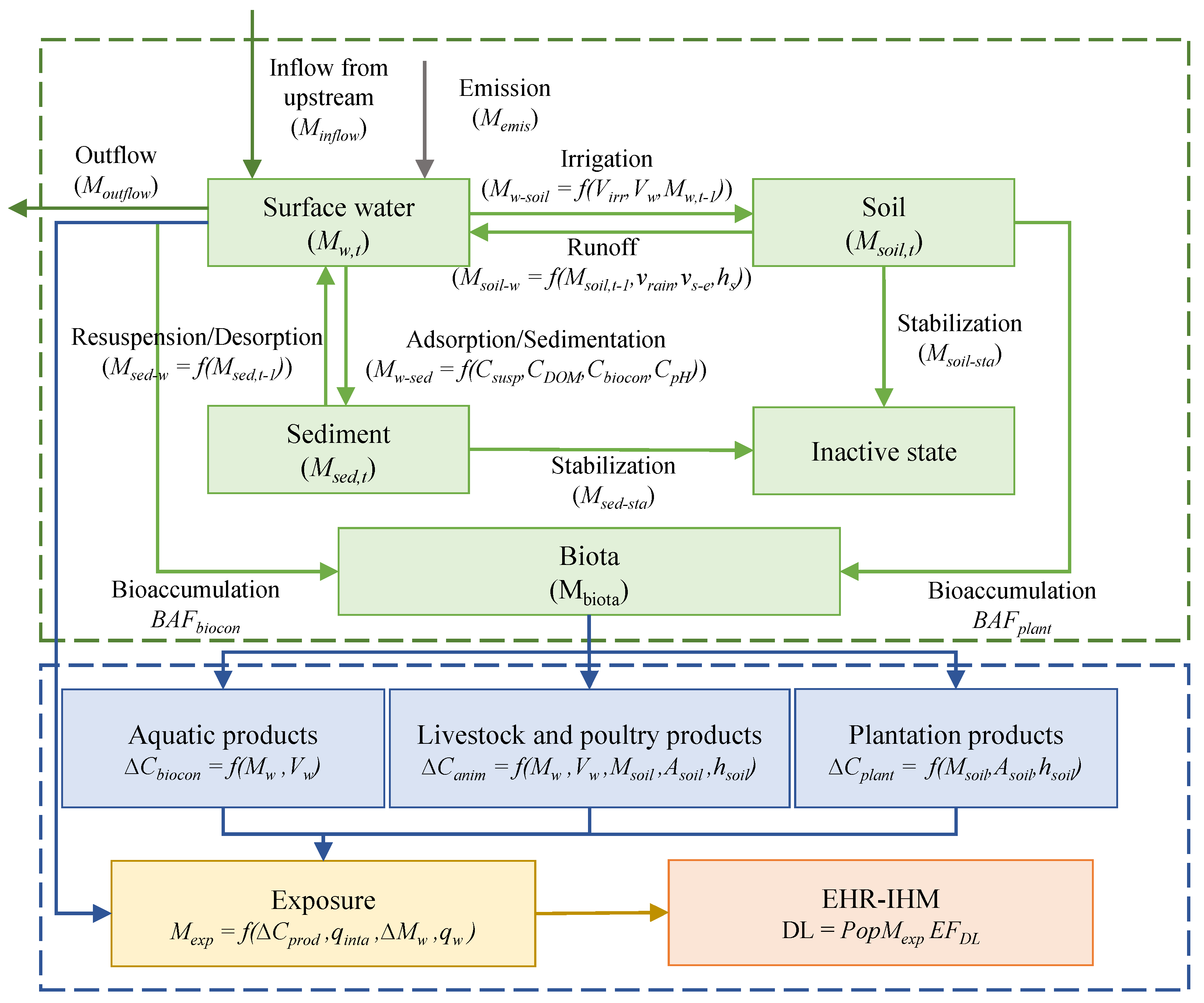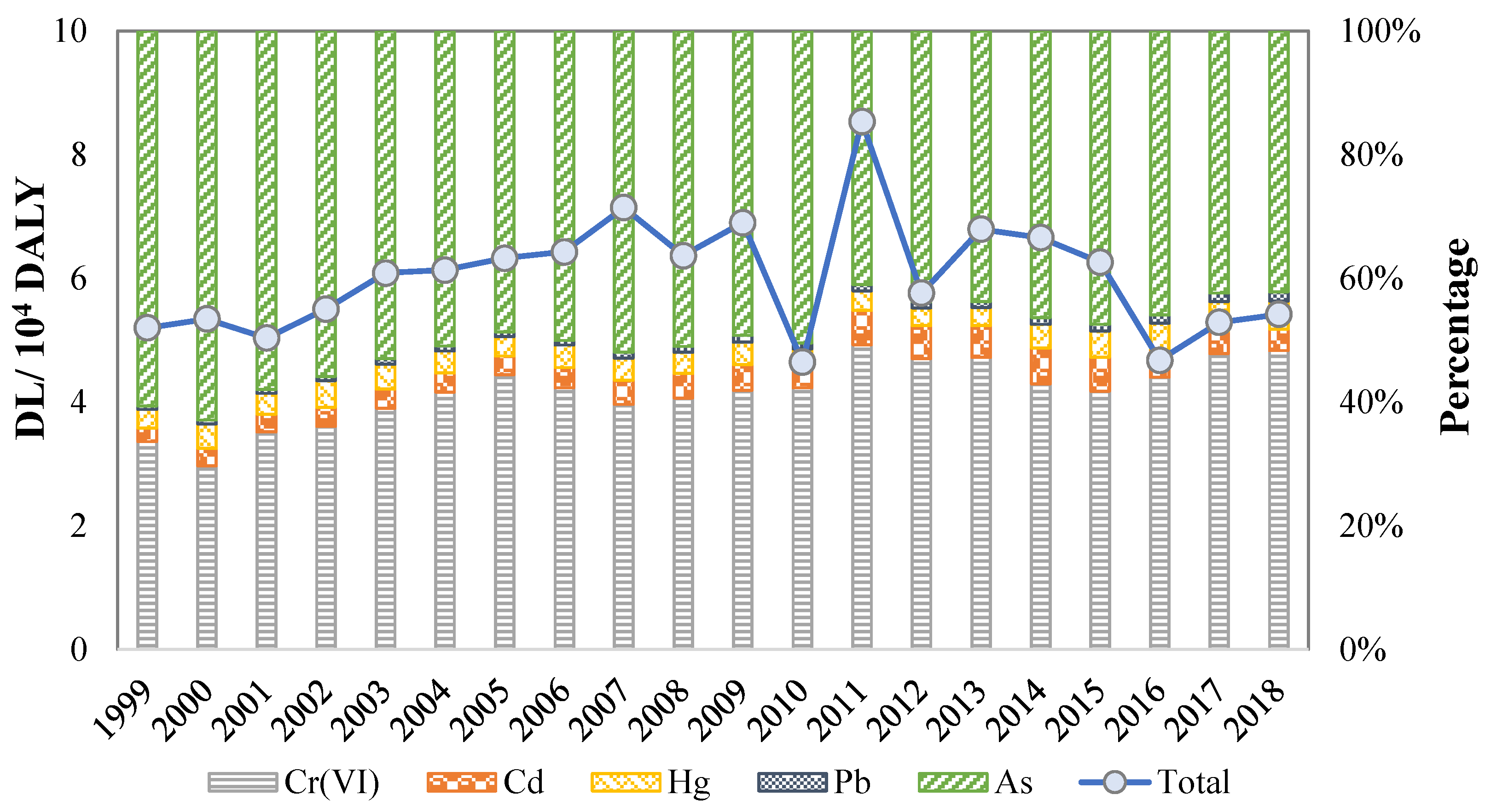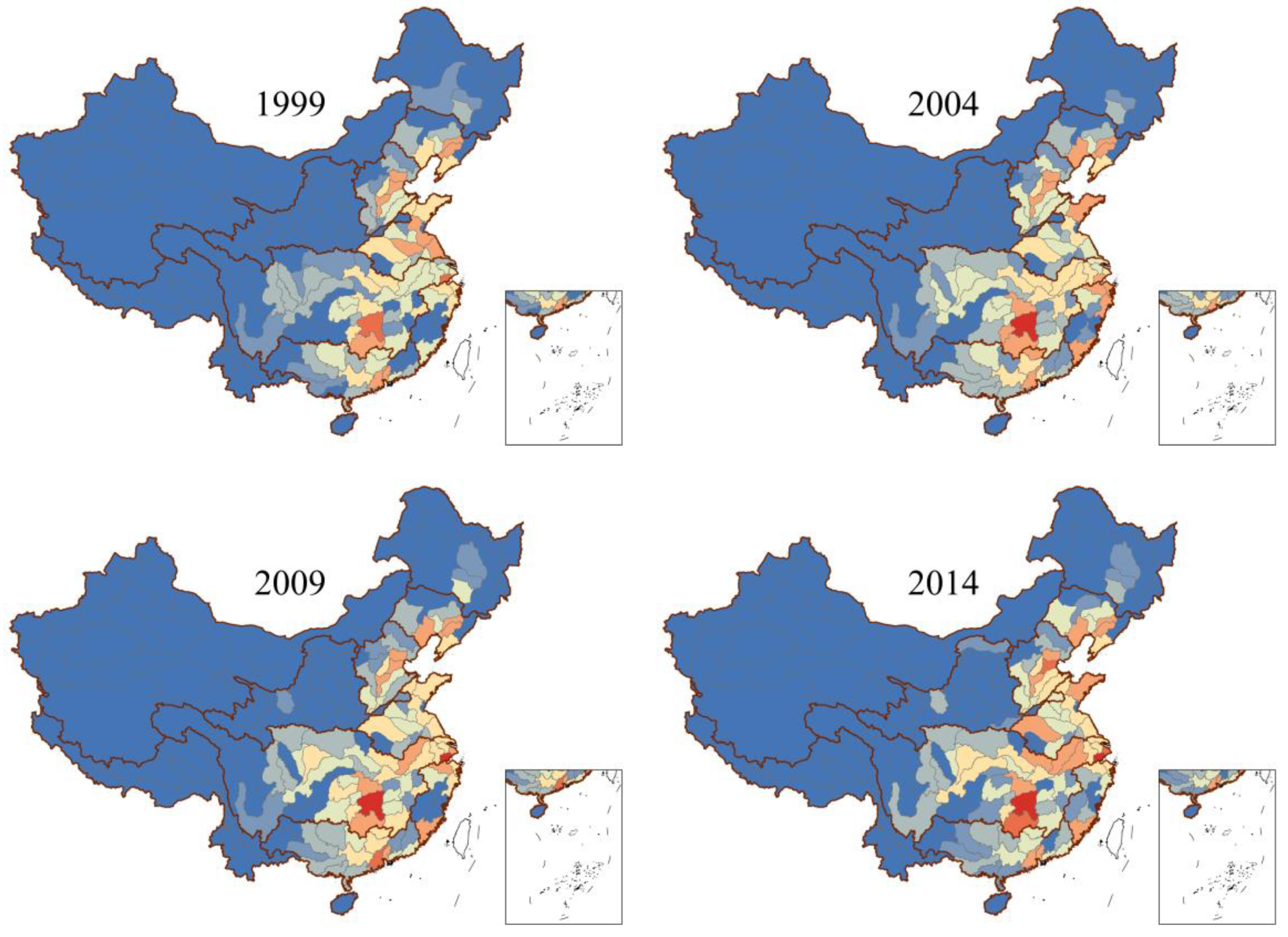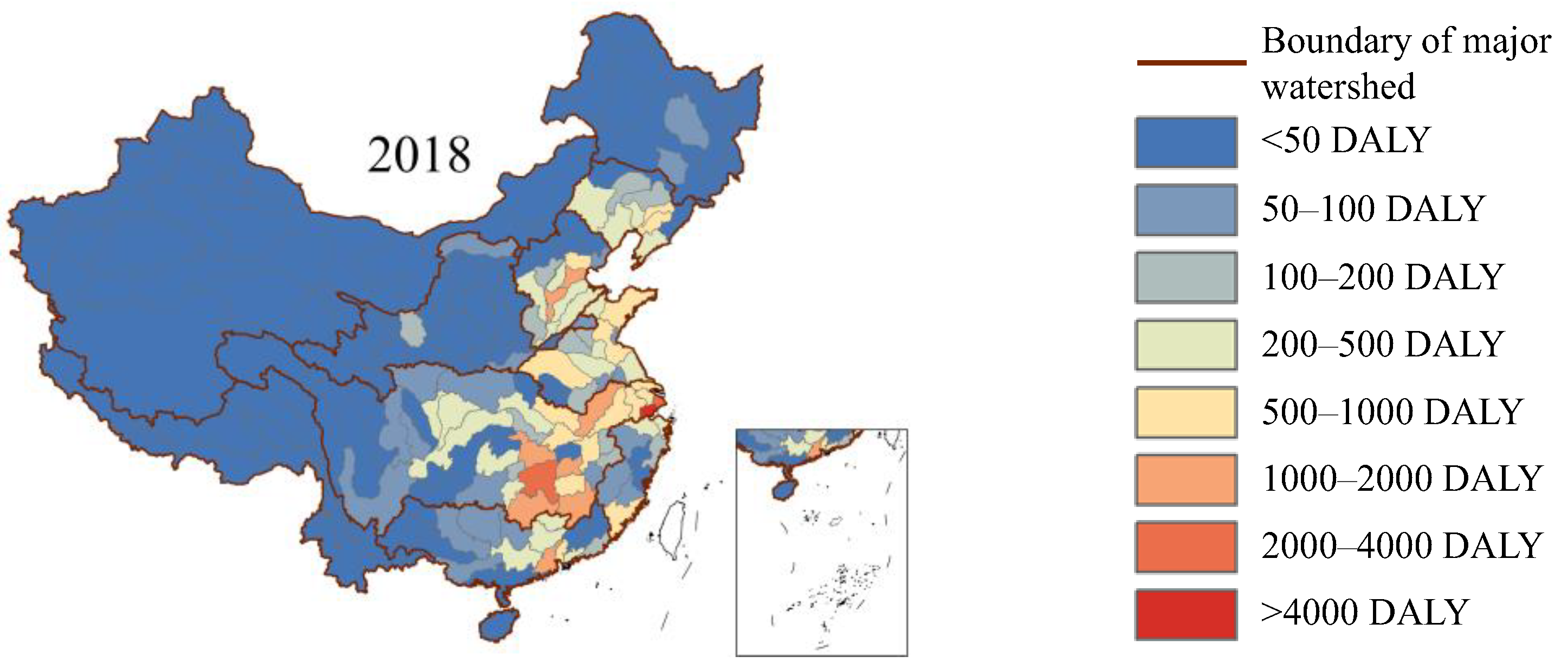Spatio-Temporal Distribution of Environmental Health Risk of Heavy Metals in Industrial Wastewater of China during 1999–2018
Abstract
1. Introduction
2. Methods and Data
2.1. The Framework of the EHR-IHM Assessment Method
2.2. The Multimedia Migration Model of Heavy Metals in Industrial Wastewater (MM-IHM)
2.3. Exposure and Risk Assessment Model of EHR-IHM
2.4. Data
3. Results and Discussion
3.1. Temporal Trend of EHR-IHM
3.2. Primary Heavy Metals
3.3. Dominant Exposure Pathways
3.4. Identification of Distribution Characteristics of High-Risk Areas
4. Limitations
5. Conclusions
Supplementary Materials
Author Contributions
Funding
Institutional Review Board Statement
Informed Consent Statement
Data Availability Statement
Conflicts of Interest
References
- Hou, D.; O’Connor, D.; Igalavithana, A.D.; Alessi, D.S.; Luo, J.; Tsang, D.C.; Sparks, D.L.; Yamauchi, Y.; Rinklebe, J.; Ok, Y.S. Metal contamination and bioremediation of agricultural soils for food safety and sustainability. Nat. Rev. Earth Environ. 2020, 1–16. [Google Scholar] [CrossRef]
- Liao, J.; Chen, J.; Ru, X.; Chen, J.; Wu, H.; Wei, C. Heavy metals in river surface sediments affected with multiple pollution sources, South China: Distribution, enrichment and source apportionment. J. Geochem. Explor. J. Assoc. Explor. Geochem. 2017, 176, 9–19. [Google Scholar] [CrossRef]
- Zhang, M.; Sun, X.; Xu, J. Heavy metal pollution in the east china sea: A review. Mar. Pollut. Bull. 2020, 159, 111473. [Google Scholar] [CrossRef] [PubMed]
- Zhuang, Q.; Li, G.; Liu, Z. Distribution, source and pollution level of heavy metals in river sediments from South China. Catena 2018, 170, 386–396. [Google Scholar] [CrossRef]
- Zhao, G.; Ye, S.; Yuan, H.; Ding, X.; Wang, J.; Laws, E.A. Surface sediment properties and heavy metal contamination assessment in river sediments of the Pearl River Delta, China. Mar. Pollut. Bull. 2018, 136, 300–308. [Google Scholar] [CrossRef]
- Xia, F.; Qu, L.; Wang, T.; Luo, L.; Chen, H.; Dahlgren, R.A.; Zhang, M.; Mei, K.; Huang, H. Distribution and source analysis of heavy metal pollutants in sediments of a rapid developing urban river system. Chemosphere 2018, 207, 218–228. [Google Scholar] [CrossRef] [PubMed]
- Lin, Y.; Yu, X.X.; Huang, L.L.; Sanganyado, E.; Bi, R.; Li, P.; Liu, W.H. Risk assessment of potentially toxic elements accumulated in fish to Indo-Pacific humpback dolphins in the South China Sea. Sci. Total Environ. 2021, 761, 143256. [Google Scholar] [CrossRef]
- Li, X.; Zhang, J.; Gong, Y.; Yang, S.; Ye, M.; Yu, X.; Ma, J. Status of mercury accumulation in agricultural soils across China (1976–2016). Ecotoxicol. Environ. Saf. 2020, 197, 110564. [Google Scholar] [CrossRef] [PubMed]
- Liu, Z.; Zhang, Q.; Han, T.; Ding, Y.; Sun, J.; Wang, F.; Cheng, Z. Heavy metal pollution in a soil-rice system in the Yangtze River Region of China. Int. J. Environ. Res. Public Health 2015, 13, 63. [Google Scholar] [CrossRef] [PubMed]
- Somma, R.; Ebrahimi, P.; Troise, C.; Natale, G.D.; Albanese, S. The first application of compositional data analysis (CoDA) in a multivariate perspective for detection of pollution source in sea sediments: The Pozzuoli Bay (Italy) case study. Chemosphere 2021, 274, 129955. [Google Scholar] [CrossRef] [PubMed]
- Buccino, M.; Daliri, M.; Calabrese, M.; Somma, R. A numerical study of arsenic contamination at the Bagnoli bay seabed by a semi-anthropogenic source. Analysis of current regime. Sci. Total Environ. 2021, 782, 146811. [Google Scholar] [CrossRef]
- Manneh, R.; Margni, M.; Deschênes, L. Spatial variability of intake fractions for Canadian emission scenarios: A comparison between three resolution scales. Environ. Sci. Technol. 2010, 44, 4217–4224. [Google Scholar] [CrossRef]
- Pennington, D.; Margni, M.; Ammann, C.; Jolliet, O. Multimedia fate and human intake modeling: Spatial versus nonspatial insights for chemical emissions in Western Europe. Environ. Sci. Technol. 2005, 39, 1119–1128. [Google Scholar] [CrossRef]
- Zhang, G.; Liu, H.; Jia, D. River basin management based on the mechanisms of water rights trading. Procedia Environ. Sci. 2010, 2, 665–673. [Google Scholar] [CrossRef][Green Version]
- Wu, W.; Wang, J.; Yu, Y.; Jiang, H.; Liu, N.; Bi, J.; Liu, M. Optimizing critical source control of five priority-regulatory trace elements from industrial wastewater in China: Implications for health management. Environ. Pollut. 2018, 235, 761–770. [Google Scholar] [CrossRef] [PubMed]
- Guinée, J. Handbook on Life Cycle Assessment—Operational Guide to the ISO Standards; Kluwer Academic Publishers: Dordrecht, The Netherlands, 2001; Volume 6, p. 255. [Google Scholar]
- Goedkoop, M.; Effting, S.; Collignon, M. The Eco-Indicator 99: A Damage Oriented Method for Life-Cycle Impact Assessment: Manual for Designers; PRé Consultants: Amersfoort, The Netherlands, 2000. [Google Scholar]
- Hauschild, M.; Potting, J. Spatial differentiation in Life Cycle impact assessment-The EDIP2003 methodology. Environ. News 2005, 80, 1–195. [Google Scholar]
- Jolliet, O.; Margni, M.; Charles, R.; Humbert, S.; Payet, J.; Rebitzer, G.; Rosenbaum, R. IMPACT 2002+: A new life cycle impact assessment methodology. Int. J. Life Cycle Assess. 2003, 8, 324–330. [Google Scholar] [CrossRef]
- Weidema, B.; Hauschild, M.; Jolliet, O. Preparing Characterisation Methods for Endpoint Impact Assessment; Institute for Prospective Technological Studies: Sevilla, Spain, 2007. [Google Scholar]
- Huijbregts, M.A.; Steinmann, Z.J.; Elshout, P.M.; Stam, G.; Verones, F.; Vieira, M.; van Zelm, R. A Harmonized Life Cycle Impact Assessment Method at Midpoint and Endpoint Level. Report I: Characterization; PRé Consultants BV: Amersfoort, The Netherlands, 2016. [Google Scholar]
- Hauschild, M.Z.; Huijbregts, M.; Jolliet, O.; MacLeod, M.; Margni, M.; van de Meent, D.; Rosenbaum, R.K.; McKone, T.E. Building a Model Based on Scientific Consensus for Life Cycle Impact Assessment of Chemicals: The Search for Harmony and Parsimony. Environ. Sci. Technol. 2008, 42, 7032–7037. [Google Scholar] [CrossRef] [PubMed]
- Bare, J.; Young, D.; Qam, S.; Hopton, M.; Chief, S. Tool for the Reduction and Assessment of Chemical and Other Environmental Impacts (TRACI); US Environmental Protection Agency: Washington, DC, USA, 2012.
- Pizzol, M.; Christensen, P.; Schmidt, J.; Thomsen, M. Impacts of “metals” on human health: A comparison between nine different methodologies for Life Cycle Impact Assessment (LCIA). J. Clean. Prod. 2011, 19, 646–656. [Google Scholar] [CrossRef]
- Fantke, P.; Bijster, M.; Guignard, C.; Hauschild, M.Z.; Huijbregts, M.; Jolliet, O.; Kounina, A.; Magaud, V.; Margni, M.; McKone, T.E. USEtox® 2.0 Documentation, version 1.00; The United Nations Environment Programme (UNEP)/Society of Environmental Toxicology and Chemistry (SETAC): Lyngby, Denmark, 2017. [Google Scholar]
- Ministry of Ecology and Environment of the People’s Republich of China. 12th Five-Year Plan for Comprehensive Prevention and Control of Heavy Metal Pollution; Ministry of Ecology and Environment of the People’s Republich of China: Beijing, China, 2011.
- Meng, M.; Sun, R.-Y.; Liu, H.-W.; Yu, B.; Yin, Y.-G.; Hu, L.-G.; Shi, J.-B.; Jiang, G.-B. An integrated model for input and migration of mercury in chinese coastal sediments. Environ. Sci. Technol. 2019, 53, 2460–2471. [Google Scholar] [CrossRef] [PubMed]
- Peng, C.; Wang, M.; Chen, W. Modelling cadmium contamination in paddy soils under long-term remediation measures: Model development and stochastic simulations. Environ. Pollut. 2016, 216, 146–155. [Google Scholar] [CrossRef]
- Alves, R.I.; Sampaio, C.F.; Nadal, M.; Schuhmacher, M.; Domingo, J.L.; Segura-Muñoz, S.I. Metal concentrations in surface water and sediments from Pardo River, Brazil: Human health risks. Environ. Res. 2014, 133, 149–155. [Google Scholar] [CrossRef]
- Wang, Z.-H.; Sun, J.; Wang, H.-J.; Liu, A.-L.; Zhang, B.; Ding, G.-Q. Dietary stucture transition and development of nutrition intervention strategies in China. Acta Nutr. Sin. 2019, 41, 427–432. [Google Scholar]
- Huang, Y.; Zhou, B.; Li, N.; Li, Y.; Han, R.; Qi, J.; Lu, X.; Li, S.; Feng, C.; Liang, S. Spatial-temporal analysis of selected industrial aquatic heavy metal pollution in China. J. Clean. Prod. 2019, 238, 117944. [Google Scholar] [CrossRef]
- Li, Y.; Zhou, Q.; Ren, B.; Luo, J.; Yuan, J.; Ding, X.; Bian, H.; Yao, X. Trends and health risks of dissolved heavy metal pollution in global river and lake water from 1970 to 2017. Rev. Environ. Contam. Toxicol. 2019, 251, 1–24. [Google Scholar]
- Lin, P.; Pan, M.; Beck, H.E.; Yang, Y.; Yamazaki, D.; Frasson, R.; David, C.H.; Durand, M.; Pavelsky, T.M.; Allen, G.H. Global reconstruction of naturalized river flows at 2.94 million reaches. Water Resour. Res. 2019, 55, 6499–6516. [Google Scholar] [CrossRef] [PubMed]
- Duan, X.; Zhao, X.; Wang, B.; Zhao, L.; Cheng, H.; Cao, S. Highlights of the Chinese Exposure Factors Handbook (Children); China Environmental Science Press: Beijing, China, 2016. [Google Scholar]
- Duan, X.; Zhao, X.; Wang, B.; Chen, Y.; Cao, S. Highlights of the Chinese Exposure Factors Handbook (Adults); Science Press: Beijing, China, 2015. [Google Scholar]
- Huang, Y.; Zhou, B.; Han, R.; Lu, X.; Li, S.; Li, N. Spatial-temporal characteristics and driving factors of the human health impacts of five industrial aquatic toxic metals in China. Environ. Monit. Assess. 2020, 192, 1–14. [Google Scholar] [CrossRef] [PubMed]
- Ministry of Water Resources of the People’s Republic of China. 2010 China Water Resources Bulletin; China Water&Power Press: Beijing, China, 2011.
- Zeng, X.; Liu, Y.; You, S.; Zeng, G.; Tan, X.; Hu, X.; Hu, X.; Huang, L.; Li, F. Spatial distribution, health risk assessment and statistical source identification of the trace elements in surface water from the Xiangjiang River, China. Environ. Sci. Pollut. Res. 2015, 22, 9400–9412. [Google Scholar] [CrossRef]
- Luo, L.; Ma, Y.; Zhang, S.; Wei, D.; Zhu, Y.-G. An inventory of trace element inputs to agricultural soils in China. J. Environ. Manag. 2009, 90, 2524–2530. [Google Scholar] [CrossRef] [PubMed]
- Shi, T.; Zhang, Y.; Gong, Y.; Ma, J.; Wei, H.; Wu, X.; Zhao, L.; Hou, H. Status of cadmium accumulation in agricultural soils across China (1975–2016): From temporal and spatial variations to risk assessment. Chemosphere 2019, 230, 136–143. [Google Scholar] [CrossRef]
- Shi, T.; Ma, J.; Zhang, Y.; Liu, C.; Hu, Y.; Gong, Y.; Wu, X.; Ju, T.; Hou, H.; Zhao, L. Status of lead accumulation in agricultural soils across China (1979–2016). Environ. Int. 2019, 129, 35–41. [Google Scholar] [CrossRef]
- Zhang, Y.; Chu, C.; Li, T.; Xu, S.; Liu, L.; Ju, M. A water quality management strategy for regionally protected water through health risk assessment and spatial distribution of heavy metal pollution in 3 marine reserves. Sci. Total Environ. 2017, 599, 721–731. [Google Scholar] [CrossRef] [PubMed]
- Agency, E.E. Mercury in Europe’s Environment—A Priority for European and Global Action; European Environment Agency: Copenhagen, Denmark, 2018.
- Du, B.; Feng, X.; Li, P.; Yin, R.; Yu, B.; Sonke, J.E.; Guinot, B.; Anderson, C.W.N.; Maurice, L. Use of mercury isotopes to quantify mercury exposure sources in inland populations, China. Environ. Sci. Technol. 2018, 52, 5407–5416. [Google Scholar] [CrossRef] [PubMed]
- National Bureau of Statistics. 2000 China Statistical Yearbook; China Statistics Press: Beijing, China, 2000.
- National Bureau of Statistics. 2018 China Statistical Yearbook; China Statistics Press: Beijing, China, 2019.
- Li, X.; Qiao, H.; Wang, R.; Li, F.; Li, X. Spatio-temporal data mining and modeling: Distribution pattern and governance input efficiency of heavy metal emission in industrial wastewater, China. J. Water Clim. Chang. 2018, 9, 307–321. [Google Scholar] [CrossRef]
- Fan, X.; Luo, H. Spatial and industrial distribution pattern of heavy metals emission in industrial waste water. China Environ. Sci. 2013, 33, 655–662. [Google Scholar]






| Exposure Routes | Dominant Agricultural Foods |
|---|---|
| Plant products | Rice |
| Wheat | |
| Vegetables | |
| Livestock and poultry products | Pork |
| Poultry | |
| Milk | |
| Aquatic products | Aquatic products |
| Parameter | Notation | Description of Data | Source |
|---|---|---|---|
| Heavy metal emissions from industrial wastewater, kg | Memis | 1 × 1 km | Huang et al. [31] |
| Irrigation volume with surface water, m3 | Virr,t | Tertiary watershed | Bulletin of Water Resources |
| Hydraulic erosion of soil, m3 | Verosion | 1 × 1 km | Resource and Environment Science and Data Center |
| Stream flows, m3 | Voutflow,t | Tertiary watershed | Li et al. [32,33] |
| Suspended matter concentration in water, kg/m3 | Csusp | Tertiary watershed | China River Sediment Bulletin |
| Gross amount of surface water resources | Vw | Tertiary watershed | Bulletin of Water Resources, Li et al. [32,33] |
| Population density | Pop | 1 × 1 km | |
| Dietary intakes | qinta | Duan [34,35] |
Publisher’s Note: MDPI stays neutral with regard to jurisdictional claims in published maps and institutional affiliations. |
© 2021 by the authors. Licensee MDPI, Basel, Switzerland. This article is an open access article distributed under the terms and conditions of the Creative Commons Attribution (CC BY) license (https://creativecommons.org/licenses/by/4.0/).
Share and Cite
Han, R.; Zhou, B.; Chen, H. Spatio-Temporal Distribution of Environmental Health Risk of Heavy Metals in Industrial Wastewater of China during 1999–2018. Int. J. Environ. Res. Public Health 2021, 18, 5920. https://doi.org/10.3390/ijerph18115920
Han R, Zhou B, Chen H. Spatio-Temporal Distribution of Environmental Health Risk of Heavy Metals in Industrial Wastewater of China during 1999–2018. International Journal of Environmental Research and Public Health. 2021; 18(11):5920. https://doi.org/10.3390/ijerph18115920
Chicago/Turabian StyleHan, Ruru, Beihai Zhou, and Huilun Chen. 2021. "Spatio-Temporal Distribution of Environmental Health Risk of Heavy Metals in Industrial Wastewater of China during 1999–2018" International Journal of Environmental Research and Public Health 18, no. 11: 5920. https://doi.org/10.3390/ijerph18115920
APA StyleHan, R., Zhou, B., & Chen, H. (2021). Spatio-Temporal Distribution of Environmental Health Risk of Heavy Metals in Industrial Wastewater of China during 1999–2018. International Journal of Environmental Research and Public Health, 18(11), 5920. https://doi.org/10.3390/ijerph18115920





